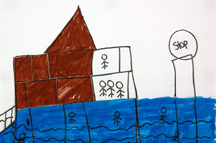“I’m not ready, but there’s a point in time when I guess you’ve got to move on,” he said.
Similar scenes played out elsewhere at the sprawling and mostly empty park Saturday as Hurricane Katrina victims prepared to leave a place many have called home for nearly three years.
The Federal Emergency Management Agency planned to close the park and its other remaining group sites Saturday, a day before the start of the hurricane season, but the agency said it would give park residents a few more days to secure new housing.
Some park residents and housing advocates have criticized FEMA’s push to empty its trailer parks, citing a lack of affordable housing in the Baton Rouge and New Orleans areas.
FEMA officials have insisted they would not evict anyone.
“Our objective is to be sensitive to individuals at this point in time,” FEMA spokesman Manuel Broussard said. “We understand some of their concerns, and we certainly are trying to bring some dignity to this whole process.”
FEMA accelerated its efforts to move trailer residents into more-permanent housing in February after government scientists found high levels of formaldehyde in some of the temporary homes. Since then, population at the parks has steadily declined as trailer residents have moved into apartments and motel rooms.
As of Saturday, there were 347 occupied trailers at Renaissance Village and FEMA’s five other group sites in Louisiana.
Renaissance, which at its peak housed 573 families, began Saturday with 38 occupied trailers and finished with 27, according to FEMA.
Broussard said most of the remaining families had signed apartment leases and would likely move as soon as details such as utilities and keys were worked out.
Most trailer residents qualify for a subsidized apartment through March 2009 or a 30-day hotel voucher.
However, a handful of remaining park residents don’t qualify for government housing assistance because they can’t prove they lived in a hurricane-affected area before the storm.
Broussard has said FEMA is working with nonprofits and the Louisiana Recovery Authority to ensure residents deemed ineligible don’t wind up homeless.
Sister Judith Brun, who runs the nonprofit Community Initiatives Foundation’s office at the park, said those ineligible residents, some of whom were homeless before Katrina, are the most difficult to place in housing.
Sister Brun’s group is partnering with other charities to provide rental assistance to the ineligible trailer residents, and she said FEMA has agreed to allow more time to resolve the most difficult cases.
“Without this added layer of support, there’s a probability that these people would be homeless,” Sister Brun said.
Near the back of the park Saturday, Gary Leeper was washing the nun’s car in the afternoon heat. He said it was his way of showing his gratitude for the assistance Sister Brun has provided him and other park residents.
Leeper, who has lived at the park since October 2005, stopped to point out a handful of occupied trailers — including a few whose tenants, he said, weren’t even looking for new housing.
“They tried to get us out of here, but some of them are just too picky,” Leeper said.
Leeper recently signed a lease on a Baton Rouge apartment, but is waiting for the electricity to be turned on before he moves.
He plans to leave Tuesday if everything goes as planned.
“I hate to move because I’ve been here for three years,” he said. “I’m used to everything around here. This is my home. This is the longest I’ve stayed anywhere for a long time.”
|



